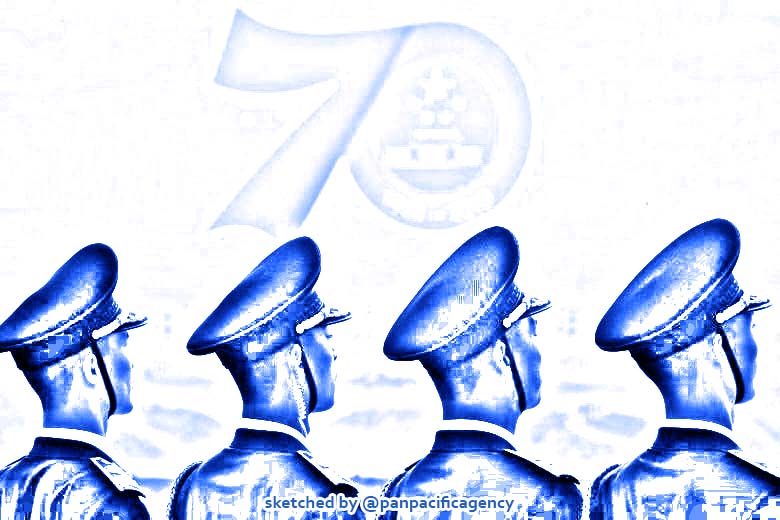[Analytics] Can Chinese military’s hip new propaganda strike chord with Generation Z?

Soldiers in front of a sign marking the 70th founding anniversary of People's Republic of China before the military parade at Tiananmen Square. PHOTO: REUTERS. Sketched by the Pan Pacific Agency.
With the armed forces now full of people born after 1995, propaganda is being designed to speak their language. Hi-tech advanced weaponry also calls for a more educated breed of recruit than in the past. Kristin Huang specially for the South China Morning Post.
Rap songs referencing hardships from a century ago. Videos featuring hit songs over footage of soldiers’ training and everyday lives, praising them for protecting the borders.
A drama series educating navy officers about online gaming addiction and cyber espionage, and a recruitment video for the air force starring pop stars and actors.
All these have an unlikely producer: China’s People’s Liberation Army.
Until recently, the PLA’s internal communications and external propaganda encouraged an image of life in the Chinese military that was stuffy and markedly detached from society.
But Generation Z – those born between 1995 and 2009 – now account for a large share of military personnel, and that generation have brought their habits, such as internet gaming and social media, into the ranks with them.
That explains the presence of singer Jackson Yee and Wolf Warrior movie actor Wu Jing in an air force video, and why military footage was set to songs such as Young For You.
In contrast with previous generations, targeted by folk songs recorded by the Chinese military’s own art academy, Gen Z is more likely to identify with Bilibili – a Chinese video sharing website themed around animation, comics and games – and learning via computer games.
Morten Ender, professor of sociology in the behavioural sciences and leadership department at the US Military Academy in New York, said it was in the Chinese military’s interest to cater to new generational habits.
“It will be futile [for the PLA] to try to resist the pervasiveness and omnipresence of social media,” Ender said. “Young people come to the military having been socialised to use these devices. They will expect to use them in whatever institutional context they find themselves in as young adults – education, work, recreation and so on.”
The more popular the culture, the easier for the military to attract and gain support from China’s young people, said Timothy Heath, senior international defence researcher from US think tank Rand.
“The military aims to recruit urban, educated, tech-savvy young people – these are the individuals the PLA needs to operate hi-tech advanced weaponry and equipment.”
Health said promoting the military through popular culture was also aimed at encouraging popular support for the PLA and the ruling Communist Party, usually by emphasising themes of nationalism and the notion that the military is the protector of the people.
“This can also help counter the negative reports of corruption in the party and the PLA,” he said.
Malcolm Davis, a senior analyst specialising in Chinese security at the Australian Strategic Policy Institute, said the PLA material was designed to get young people enthusiastic about a military career, rather than focus purely on a civilian life.
“It’s a recruiting tool to appeal to a younger Chinese generation to join the military – in particular, the release of promotional videos showing the PLA using the latest military capabilities in operational environments,” he said, adding that sustaining recruitment, particularly of educated people, was vital to keep up with China’s military ambitions.
China military: how Beijing is pushing its plan for a modern armed forces
4 Dec 2020
The PLA was once full of peasant farmers, but it is increasingly seeking college graduates as it incorporates sophisticated weapons such as drones, hypersonic missiles and stealth fighters.
In 2001, it began recruiting those with a college background. By 2014, nearly 150,000 of the PLA’s 400,000 annual recruits were college students and graduates.
Retention continues to be a challenge, and high school graduates still comprise the largest single source of recruits.
Florian Schneider, director of the Leiden Asia Centre in the Netherlands, said the PLA’s promotional efforts were not that different to those by the US armed forces, “even if they are tailored to mainland Chinese aesthetic sensibilities”.
For example, the US military makes recruitment videos that target internet-savvy young people, and allows film producers to use its equipment if military officials believe a movie could help recruitment or act as a positive advertisement.
“It is telling that Communist Party propaganda increasingly uses themes from pop culture, especially youth culture, and releases this material on social media platforms,” Schneider said.
“These youthful propaganda videos often use memes and stylistic elements from anime, manga and video games to appeal to young users.”
As a member of Gen Z, Xiong Zhi, born in 1997 and an education professional in Wuhan, said he both welcomed the portrayal of the military and saw its limitations.
“I really like some of the videos that remind us, born in peaceful times, that the PLA’s sacrifice gives us the life we enjoy,” he said.
“However, our generation is more confident than previous ones, and military hardware is a bit distant from our daily lives.”
Some aspects of the message may prove a hard sell, Heath said. The meetings, speeches, briefings and documents often favoured in party circles are not everyone’s idea of fun.
“There is only so much a video designer can do to make party documents about economic planning look exciting and cool,” he said.
Schneider said convincing new audiences with these propaganda efforts may be a long shot.
“Something is only hip and cool as long as it remains part of a subculture,” he said. “Once official actors show up on platforms popular with young people to sell them mainstream messages, those platforms become decidedly less cool.
“The hip, young audiences move on, and the propaganda effort only reaches those who were already on board.”